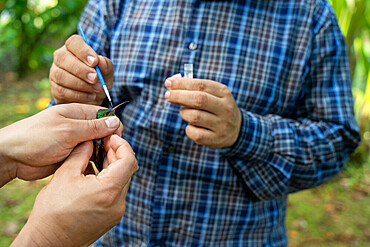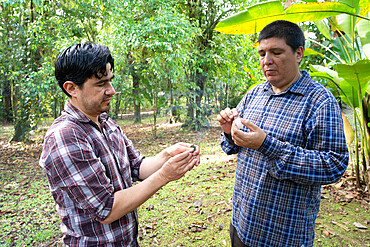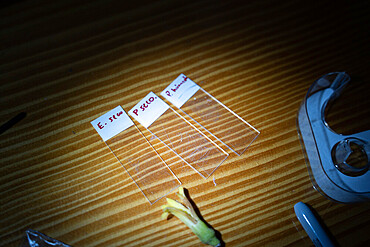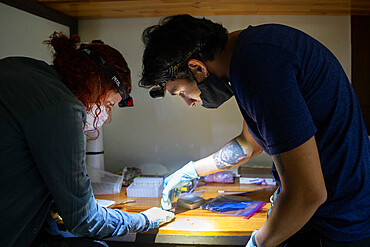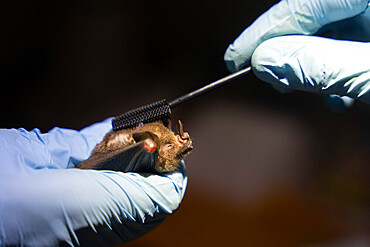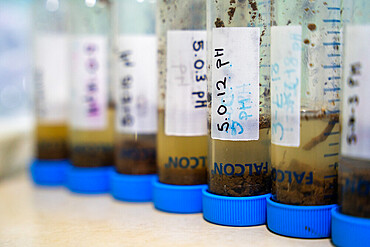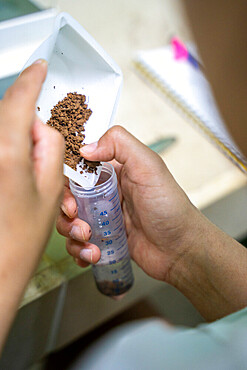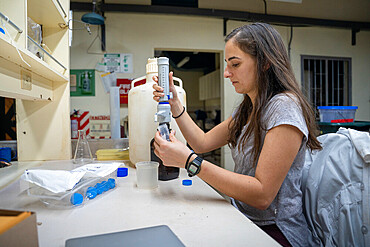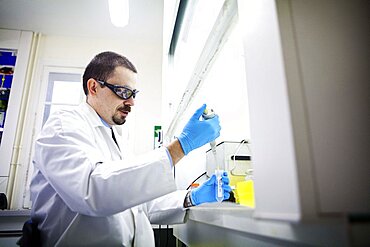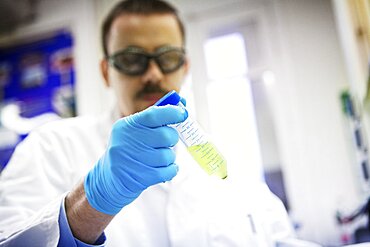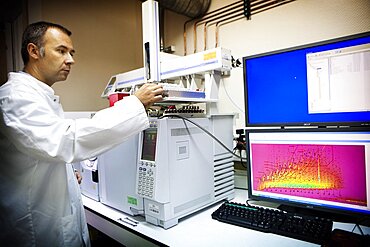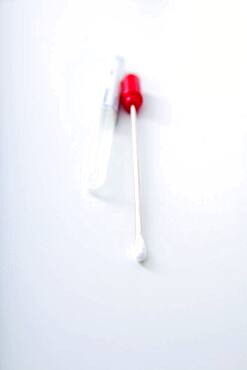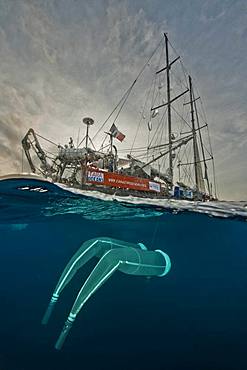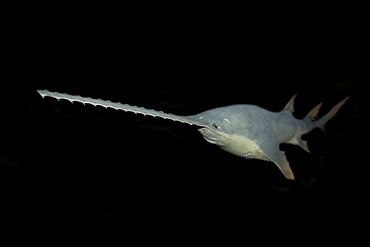Recent searches
Loading...
832-403677 - Side view researcher biotechnology laboratory with plant test tube
860-291440 - Researchers picking up pollen with a brush from the beak of a hummingbird Stripe-throated Hermit as part of a pollination study, rainforest at the "La Selva" research station in Puerto Viejo de Sarapiqui, Costa Rica
860-291438 - Researchers picking up pollen with a brush from the beak of a Rufous-tailed hummingbird as part of a pollination study, rainforest at the "La Selva" research station in Puerto Viejo de Sarapiqui , Costa Rica
860-291437 - Researchers picking up pollen using tape on the beak of a Rufous-tailed hummingbird as part of a pollination study, rainforest at the "La Selva" research station in Puerto Viejo de Sarapiqui, Costa Rica
860-291430 - Researchers applying a mascara brush to the hairs of a Sowell's short-tailed bat (Carollia sowelli) to test methods to capture pollen that bats may carry as part of a pollination study, rainforest at the "La Selva" research station in Puerto Viejo de Sarapiqui, Costa Rica
860-291429 - 3 microscope slides to analyze pollen transported on bat hairs, "La Selva" research station in Puerto Viejo de Sarapiqui, Costa Rica
860-291427 - Researchers applying tape to the hairs of a bat to test methods to capture the pollen it carries as part of a pollination study, rainforest at the 'La Selva' research station in Puerto Viejo de Sarapiqui, Costa Rica
860-291428 - Researchers applying a mascara brush to the hairs of a Sowell's short-tailed bat (Carollia sowelli) to test methods to capture pollen that bats may carry as part of a pollination study, rainforest at the "La Selva" research station in Puerto Viejo de Sarapiqui, Costa Rica
860-291422 - Earth diluted with water in order to extract the PH from the soil as part of a study on nitrogen exchanges between bacteria and the roots of legumes in the tropical forest of the "La Selva" research station in Puerto Viejo from Sarapiqui, Costa Rica
860-291420 - Earth diluted with water in order to extract the PH from the soil as part of a study on nitrogen exchanges between bacteria and the roots of legumes in the tropical forest of the "La Selva" research station in Puerto Viejo from Sarapiqui, Costa Rica
860-291419 - 27-year-old researcher working in a lab on nitrogen exchange between bacteria and the roots of legumes in the rainforest at the "La Selva" research station in Puerto Viejo de Sarapiqui, Costa Rica
832-401052 - 2 specimens of west indian manatee (Trichechus manatus) grazing in the Crystal River, Florida, USA, North America
1350-6274 - Portrait of a juvenile specimen of damselfish (Chromis chromis). Before taking the typical dark brown color of their adult form, these fishes have magnificent electric blue bands. The juvenile specimens are very small, a few centimeters, and they move with nervous and unpredictable movements without any moment of pause.
832-394398 - Histological preparations in the laboratory with protocol, Freiburg, Baden-Wuerttemberg, Germany, Europe
1348-3928 - Clinical research in the GHICL. The physical medicine and rehabilitation department in Saint Philibert hospital in Lille, France. Exercises to develop the patient's muscle tone in functional rehabilitation, under the supervision of a doctor.
1178-32795 - Indian male scientist holding DNA model
1178-32794 - Indian male scientist looking at DNA film
1349-685 - PAS Stain Specimen Revealing Histoplasmosis, LM
1350-562 - Female scientist looks down to examine various cultures of peanut plant roots, Tifton, Georgia.
1348-130 - This transmission electron micrograph from a pelleted specimen depicts three icosahedral-shaped herpes virus virions. The staining technique used to process this specimen revealed the following findings: virions with a dark center, where the stain has pen
1116-49671 - Research divers from the MOC Marine Institute map out coral damage at Molokini Marine Preserve off the island of Maui, Hawaii. In the future, data from here will help to determine the health of Hawaii's reefs, Maui, Hawaii, United States of America
1116-49673 - Research divers from the MOC Marine Institute glue broken coral heads back together and map out coral damage at Molokini Marine Preserve off the island of Maui, Hawaii. In the future, data from here will help to determine the health of Hawaii's reefs, Maui, Hawaii, United States of America
860-287451 - Tara Oceans Expeditions - May 2011. Surface plancton nets, deployed from Tara, Galapagos
860-287449 - Tara Oceans Expeditions - May 2011. Surface plancton nets, deployed from Tara, Galapagos
860-287450 - Tara Oceans Expeditions - May 2011. Tara with deployed plancton nets. On "station", the boat is drifting without engine or sails. Tara Oceans, a unique expedition: Tara Oceans is the very first attempt to make a global study of marine plankton, a form of sea life that includes organisms as small as viruses and bacterias, and as big as medusas. Our goal is to better understand planktonic ecosystems by exploring the countless species, learning about interactions among them and with their environment. Marine plankton is the only ecosystem that is almost continuous over the surface of the Earth. Studying plankton is like taking the pulse of our planet. Recently, scientists have discovered the great importance of plankton for the climate: populations of plankton are affected very rapidly by variations in climate. But in turn they can influence the climate by modifying the absorption of carbon. In a context of rapid physico-chemical changes, for example the acidification observed today in the world's oceans, it is urgent to understand and predict the evolution of these particular ecosystems. Finally, plankton is an astonishing way of going back in time ? a prime source of fossils. Over the eons, plankton has created several hundred meters of sediment on the ocean floors. This allows us to go back in time, to the first oceans on Earth, and better understand the history of our biosphere. More than 12 fields of research are involved in the project, which will bring together an international team of oceanographers, ecologists, biologists, geneticists, and physicists from prestigious laboratories headed by Eric Karsenti of the European Molecular Biology Laboratory. Galapagos
920-1479 - Whale shark (Rhincodon typus) pup specimen, circumglobal in warm and temperate seas
920-2152 - Dogfish (Hydrolicus pectoralis), jaw detail on preserved specimen, Amazon river basin, Amazonas, Brazil, South America
920-2162 - Piranha (Serrasalmus sp.), preserved specimen, Manaus, Amazonas, Brazil, South America
920-2151 - Sawfish (Pristis pectinatus), preserved specimen, Amazon River Basin, Amazonas, Brazil, South America
911-3755 - A Chlamydia self testing kit, United Kingdom, Europe
920-2155 - Red tailed catfish (Phractocephalus hemiliopterus), preserved specimen, Manaus, Amazonas, Brazil, South America
920-2158 - Sawfish (Pristis pectinatus), preserved specimen, Amazon River Basin, Amazonas, Brazil, South America
920-2154 - Tiger catfish (Pseudoplatystoma fasciatum), preserved specimen, Manaus, Amazonas, Brazil, South America
920-2157 - Sucker catfish (Acanthicus hystrix), preserved specimen, Manaus, Amazonas, Brazil, South America
920-2156 - Sucker catfish (Acanthicus hystrix), preserved specimen, Manaus, Amazonas, Brazil, South America
920-2161 - Matamata (Chelys fimbriata), preserved specimen, Manaus, Amazonas, Brazil, South America
911-3754 - A Chlamydia self testing kit, United Kingdom, Europe
911-4652 - A specimen conifer tree in a garden, Cornwall, England, United Kingdom, Europe
817-323418 - Landscape view of Sanchi Stupa No, one, Sanchi, Madhya pradesh, India
817-319364 - Horses and elephants occupy the space between architraves Uttari toran dwar, North gate, Stupa one, Sanchi, Madhya pradesh, India
817-261896 - Fine crystal art glass specimen circa 1876 in Sandwich Glass Museum Cape Cod, Massachusetts, USA
817-174325 - Dinosaur saurian primitive times bird (Archaeopteryx lithographica) Eichstatt specimen, Found in 1951 near Workerszell in the vicinity of Eichstatt, This fossil is housed at the Juramuseum in Eichstaett, Bavaria/Germany
817-124896 - Common Cobra (Naja naja) with its hood raised, Venomous, Captive specimen, Katraj Snake Park, Pune, Maharashtra, India
817-30451 - Watching an insect, red palm weevil (Rhynchophorus ferrugineus) It's a pest for palm plantations, Its larvae excavate holes up to a meter long in the trunk of palm trees, and can kill the host plant.
796-140 - Sea nettle jellyfish (chrysaora fuscescens), Monterey Aquarium, California, United States of America, North America
You reached the end of search results


